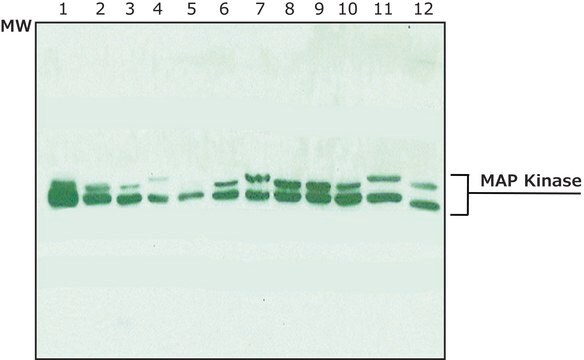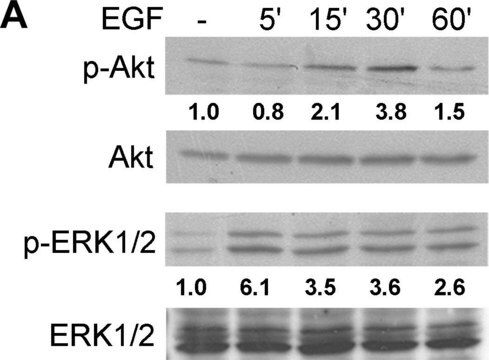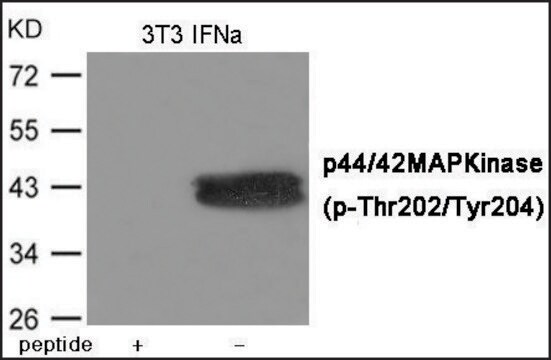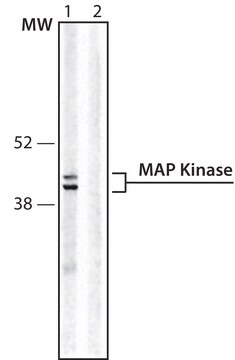M9692
Anti-MAP Kinase, Activated (Diphosphorylated ERK-1&2) antibody, Mouse monoclonal
clone MAPK-YT, purified from hybridoma cell culture
Synonim(y):
Monoclonal Anti-MAP Kinase, Activated (Diphosphorylated ERK-1&2)
About This Item
Polecane produkty
pochodzenie biologiczne
mouse
Poziom jakości
białko sprzężone
unconjugated
forma przeciwciała
purified immunoglobulin
rodzaj przeciwciała
primary antibodies
klon
MAPK-YT, monoclonal
Postać
buffered aqueous solution
masa cząsteczkowa
antigen ERK-1 44 kDa
antigen ERK-2 42 kDa
reaktywność gatunkowa
human, Caenorhabditis elegans, Xenopus, Drosophila, hamster, rat, bovine, mouse, yeast
opakowanie
antibody small pack of 25 μL
stężenie
1.5-2 mg/mL
metody
immunocytochemistry: suitable
immunohistochemistry (formalin-fixed, paraffin-embedded sections): suitable
immunoprecipitation (IP): suitable
indirect ELISA: suitable
microarray: suitable
western blot: 0.5-1 μg/mL using a whole cell extract of RAT-1 cells treated with vanadate and H2O2.
izotyp
IgG1
numer dostępu UniProt
Warunki transportu
dry ice
temp. przechowywania
−20°C
docelowa modyfikacja potranslacyjna
unmodified
informacje o genach
human ... MAPK1(5594) , MAPK3(5595)
mouse ... Mapk1(26413) , Mapk3(26417)
rat ... Mapk1(116590) , Mapk3(50689)
Szukasz podobnych produktów? Odwiedź Przewodnik dotyczący porównywania produktów
Opis ogólny
Anti-MAP Kinase, Activated (Diphosphorylated ERK-1&2) antibody, Mouse monoclonal (mouse IgG1 isotype) is derived from the MAPK-YT hybridoma produced by the fusion of mouse myeloma cells (NS1) and splenocytes from BALB/c mice immunized with a synthetic phosphorylated peptide containing amino acids corresponding to the phosphorylated form of ERK-activation loop, conjugated to KLH. The isotype is determined by a double diffusion immunoassay using Mouse Monoclonal Antibody Isotyping Reagents, Product Number ISO2.
Specyficzność
Immunogen
Zastosowanie
Monoclonal Anti-MAP Kinase, activated (Diphosphorylated ERK-1&2) antibody produced in mouse has been used in detection of
- ERK1/2 in cardiac myocytes using immunofluorescence microscopy
- ERK1/2 in human eosinophils using western blotting
- ERK in human bronchial epithelial cells using protein array
- ERK proteins in human liver cell lines using immunofluorescence assay and western blot analysis
- ERK1/2 in human embryonic kidney cells by immunoprecipitation
Działania biochem./fizjol.
Monoclonal Anti-MAP Kinase, Activated (Diphosphorylated ERK-1 and 2) is specific for the active, dually-phosphorylated form of MAP kinase (ERK-1 and ERK-2, 44 kDa and 42 kDa, respectively). The epitope recognized by the antibody contains the phosphorylated threonine and tyrosine residues within the regulatory site of active MAP kinase (Thr183 and Tyr185 in ERK-2). It does not recognize the non-phosphorylated or the monophosphorylated forms of the MAP kinase molecule or the diphosphorylated form of Jun-kinase (JNK) and p38 MAP kinase.
Signaling pathways mediated by MAPK are associated in the pathogenesis of neurodegenerative disorders and cancer. Deletion in the ERK1 gene locus is associated with DiGeorge syndrome (DGS) and velocardiofacial syndrome (VCFS) and congenital heart defects. Rearrangements in MAPK3 gene locus may contribute in the pathogenesis of autism spectrum disorders and schizophrenia.
Postać fizyczna
Przechowywanie i stabilność
Oświadczenie o zrzeczeniu się odpowiedzialności
Not finding the right product?
Try our Narzędzie selektora produktów.
Kod klasy składowania
12 - Non Combustible Liquids
Klasa zagrożenia wodnego (WGK)
nwg
Temperatura zapłonu (°F)
Not applicable
Temperatura zapłonu (°C)
Not applicable
Środki ochrony indywidualnej
Eyeshields, Gloves, multi-purpose combination respirator cartridge (US)
Certyfikaty analizy (CoA)
Poszukaj Certyfikaty analizy (CoA), wpisując numer partii/serii produktów. Numery serii i partii można znaleźć na etykiecie produktu po słowach „seria” lub „partia”.
Masz już ten produkt?
Dokumenty związane z niedawno zakupionymi produktami zostały zamieszczone w Bibliotece dokumentów.
Produkty
Alzheimer's disease (AD) is the most common cause of dementia in the elderly and is characterized by gradual loss of cognitive functions.
Nasz zespół naukowców ma doświadczenie we wszystkich obszarach badań, w tym w naukach przyrodniczych, materiałoznawstwie, syntezie chemicznej, chromatografii, analityce i wielu innych dziedzinach.
Skontaktuj się z zespołem ds. pomocy technicznej








